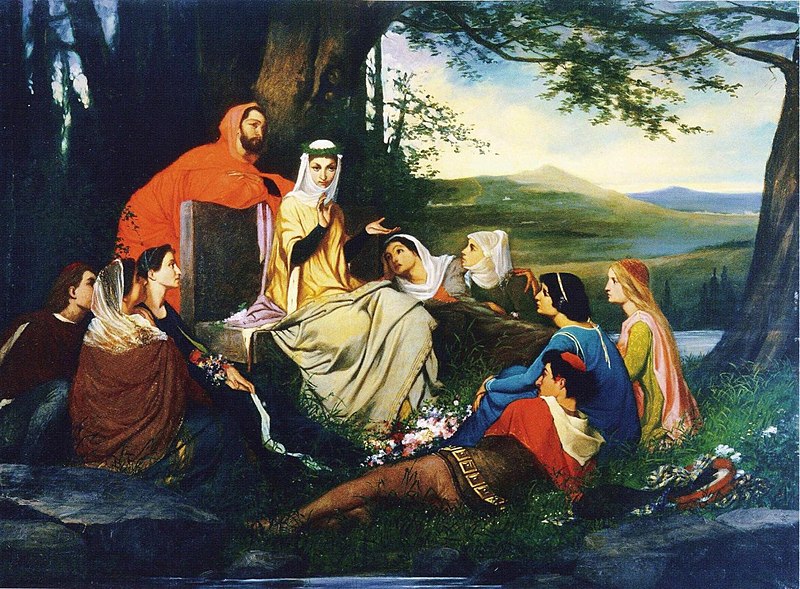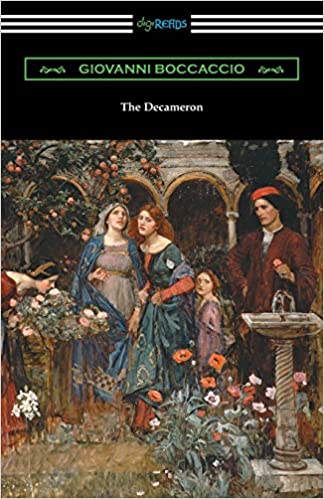essays
A Book of Medieval Italian Sex Stories Can Help Us Get Through the Pandemic
Boccaccio's "Decameron" shows that storytelling is a means of connection and survival

From the east to the west comes a deadly plague, a “death-dealing pestilence,” that has devastated Italy and has no known cure; one that baffles physicians, and spreads too quickly for many to take preventative measures; where touching something that an infected person has touched is enough to get the disease yourself; where some ignore the severity of the pandemic and go about carousing, while those who know best quarantine themselves.
So begins Giovanni Boccaccio’s 1353 The Decameron.
The current generation of students and scholars may wish to consider taking a deeper look at this newly relevant text, which offers both haunting parallels. Besides the transmission pattern of the disease—east to west, spread through touch, decimating Italy—there’s the way that the population grasps for ritualized but ineffectual remedies. In his opening description of the plague Boccaccio has a long paragraph on how people hold “odoriferous herbs and other some divers kinds of spiceries” to their noses, in accordance with the prevailing miasma theory, that held that diseases were spread by bad air and scents. This is akin to wearing a surgical mask nowadays, in terms of ubiquity, and also in terms of effectiveness at preventing you from getting sick (neither one works).
There’s also the way that in the face of isolation, people turn to a different remedy altogether. They embrace storytelling as a way to survive. Technology changes, but human responses remain remarkably similar.
Boccaccio published The Decameron two years after the Black Death (1348 to 1351) had ravaged his home city, Florence, which had lost between 45 and 75 percent of its population to the plague. He drew from his own experiences in creating the world of uncertainty, terror, and loss that leads his ten young Florentines—seven ladies and three gentlemen—to voluntarily withdraw from the city and society for two weeks, and to tell each other stories to fend off boredom or malaise. Each person takes a turn being “king” or “queen” for the day, and one of their duties as temporary ruler is setting the theme for that day’s stories. Only Dioneo, whose tales are the bawdiest, is allowed to break from this structure, and tell the last tale of each day however he chooses and on whatever subject he chooses, as a tribute to his wit. The stories focus on hope at times—how happiness follows misfortune, or the power of a witty retort—but every storyteller returns, and turns, to Fortune’s wheel. Underlying each story is the struggle to understand the vagaries of fortune. No hero or heroine in these collected tales ever lives through the narrative they expect, or that the reader expects when the protagonist is introduced. Virgin princesses become courtesans and become virgin princesses again. The worst man in the world becomes a local saint. Virtuous women are raised from peasants to marquises and by acts of arbitrary cruelness, cast down and raised up once again.
When the traditional narratives of society collapse, creating your own narratives can be a bulwark against the onrushing chaos.
The rigid structure of the work—ten characters tell ten stories for ten days—seems at odds both with the chaotic setting of the plague and with the content of the tales, where characters tumble from fortune to misfortune to fortune again, with each spin of Fortune’s wheel. But this strict structure is intentional. Just as Boccaccio most likely wrote these tales as a way to understand and also escape the plague, so do his ten storytellers embrace this structure as an escape from the now ordinary chaos of their lives. The ten storytellers are stuck in one place for two weeks; well then, so are some of their characters, while others wander around the Mediterranean like Odysseus. They do not know if they will live or die; their characters contemplate death, arrange for burials, hide in tombs, or make miraculous recoveries. When the traditional narratives of society collapse in the face of a pandemic—the minor ones like your daily routine, or the major ones, like the course of your life or career—creating your own narratives can be a bulwark against the onrushing chaos. It can help you to regain some sense of lost structure, assert some order, some sense of comprehensible cause-and-effect against massive upheavals whose workings are, as of yet, imperfectly understood.
Boccaccio’s The Decameron offers not only a parallel, but a path forward. In this time of “social distancing” and sudden telework, where two-week quarantines are once again the norm, it can be easy to become fixated on the chaos of endlessly changing news cycles to the exclusion of all other activities. The act of storytelling can seem impossible. How can one create in such an environment? I personally find it telling that our ten Florentine ladies and gentlemen do not just tell stories to pass the time, and they never begin their days with it. They take walks about the grounds, they play the viol, sing “quaint and merry ditties,” eat together, weave garlands, rest, and dance. But they do tell stories at the same time every day, creating a space for creation… generally after a “repose.” In re-reading The Decameron during the pandemic, I was struck with just how often the ladies and gentlemen in the frame story rest, and how the exchange of stories was more about community building and psychological processing than a capitalist drive to optimize production.
I doubt that I am alone in seeing all the posts about Shakespeare writing King Lear during quarantine, or Newton discovering the laws of physics, and becoming frustrated by my own lack of productivity. I’m a writer. I process the world through words. Why aren’t I writing? Why instead am I endlessly refreshing Twitter and retweeting puns about Zoom calls, or making jokes about my cats being my new supervisors? The Decameron may initially seem like a similar scold: these ten characters came up with a story a day for ten days!
But these are fictional people. Unlike the tweets valorizing productivity as the only acceptable use of one’s social distancing, self-isolation, or quarantine, the frame story of The Decameron serves a different purpose: setting up storytelling not as a responsibility but as a recourse. The ten quarantine Florentines aren’t trying to create a product to sell; they are intentionally creating and cementing social bonds. Storytelling is a means of community building, one that fits in with resting, with enjoying other forms of art, with taking solitary walks outdoors, and with singing and making music.
The Decameron sets up storytelling not as a responsibility but as a recourse.
We already seem to be telling each other stories on mutually agreed upon topics: our pets as our new coworkers; jokes about how introverts have prepared for this day; pacts not to DM your exes in the loneliness of quarantine; the ways to make telecommuting work for those unaccustomed to it; the total absence of toilet paper from grocery store shelves; jokes about the mundanity of daily life during what feels like the end times; and how our political leaders have failed us. (Some of those stories have already taken a more formal, Decameronesque shape. The Social Distancing project collects volunteered gossip and complaints about the strain that forced cohabitation can put on a relationship, and collects donations from gawkers, which are parceled out to food banks and relevant charities.) “Flatten the curve!” has become our rallying cry before or after stories of voluntary isolation, as fixed a phrase as “Once upon a time,” or “They lived happily ever after.” And then there are the viral tweets and videos of community creation: the bingo games in Spain, the concerts in Italian towns, and the hand-washing song and dance in Vietnam. We have also taken to social media to share what stories we have turned to in comfort or in escape. I have lost count of the number of Twitter threads where people have volunteered to recommend books to others, based on genres, other books, or tropes they like. To offer a favorite story is in some way to offer a piece of yourself. Though we cannot be in physical contact, we can still touch each other.
It is also telling that the storytellers in The Decameron are not focused on disease, or any scientific, logical, or authoritative response to disease. Their interest lies in luck, in love—and above all, in sex. The stories in The Decameron are very bawdy, and the storyteller allowed the most freedom is the one whose stories are most focused on sex. They’re not dissimilar to some of the stories now popular in the face of the pandemic: the jokes about quarantine babies, the photos of sex toys as necessary companions in our isolation, the repeated assertion that old-fashioned courtship might have to replace hook-up culture now that we have to keep our distance from others. I am inclined to promote the latter. If the crowded bars in downtown D.C. or New York or any other U.S. city (despite all the warnings from experts that social distancing is now essential!) are any indication, the drive for physical pleasure is stronger than almost any other human response. But here again, Boccaccio’s fictional storytellers offer an avenue of connection. So we must isolate the body—so what? We have hundreds of new ways of sharing the mind, the heart, the spirit. Channel Jane Austen. Focus on conversation and written communication; learn to enjoy the yearning, and the extended wait before physical consummation. (And take long walks for exercise if you can keep six feet away from other people.)
Create your own stories, or share those you love to strengthen your connections with others. There’s no shame in escaping into your own created world, or in recognizing that global pandemics have a negative impact on one’s ordinary standards of productivity and creativity. Many of the stories Boccaccio included in The Decameron are retellings, stories Boccaccio found interesting or useful, and decided to change for his Italian audience. I have personally found more comfort in seeing how many people are sharing the stories people are turning to, or recommending to each other, than struggling to write something in between stress-cleaning and mediating on my own mortality. As the late, great Terry Pratchett once said, “we are Pan narrans, the storytelling chimpanzee.” Let us gather round the bonfires of social media and share stories. The ones that help us to understand, or to escape, or to take some comfort in the continuing anxiety and ambiguity of modern existence. It has been, and always will be, the way our species survives.









